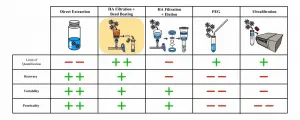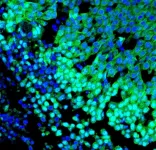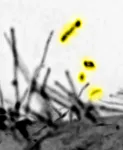New treatment proves more effective and less toxic for neuroendocrine tumor patients
2021-03-22
(Press-News.org) Reston, VA--A new treatment for late-stage neuroendocrine tumors (NETs) has been found to be more effective and have fewer side effects than the current standard of care, according to research published in the March issue of The Journal of Nuclear Medicine. The novel peptide receptor radionuclide therapy holds promise to reduce mortality among NET patients and decrease the financial burden of their continual treatment.
NETs are a diverse group of tumors that originate from the neuroendocrine system, which is responsible for regulating hormones throughout the body. The number of people who are diagnosed with NETs is growing; the incidence of NETs increased 6.4-fold from 1973 to 2012. However, because they are rare, varied, and slow growing, the diagnosis of a NET can be delayed up to seven years. As a result, more than 50 percent of NET cases are at an advanced stage at the time of diagnosis.
The current standard of care for late-stage NET patients is peptide receptor radionuclide therapy with 177Lu-DOTATATE, which is flushed from a patient's system rapidly after administration. Preclinical studies found that if a special dye (Evans blue) is added to the 177Lu-DOTATATE, the treatment can last longer in the body and be more effective. In this study, researchers sought to determine what dose of the modified therapy, known as 177Lu-DOTA-EB-TATE, is safest and produces the best tumor response.
Study participants were divided into three groups, and each group was given a different dose of 177Lu-DOTA-EB-TATE. All the groups tolerated the therapy well, with almost no side effects regardless of the dose. Ultimately, researchers found that a 177Lu-DOTA-EB-TATE dose of 1.89 GBq/cycle was the most effective for tumor control in the NET patients. They also noted that with careful patient selection and monitoring, a 3.97 GBq/cycle dose could achieve an even better response.
"In terms of NETs, the more effectively we can use 177Lu for treatment, the more we will be able to reduce the financial strain on patients," said Xiaoyuan (Shawn) Chen, PhD, Nazarat Muzayyin Chair professor at the National University of Singapore in Singapore. "Overall, this new treatment has the potential to significantly impact mortality and morbidity for neuroendocrine tumor patients."
He continued, "Now that we understand the efficacy of Evans blue dye in NET treatment, we hope that it can be utilized in the future to create various novel therapeutic radiopharmaceuticals not just for NET patients, but for other types of cancer patients as well."
INFORMATION:
This study was made available online in August 2020 ahead of final publication in print in March 2021.
The authors of "Peptide Receptor Radionuclide Therapy of Late-Stage Neuroendocrine Tumor Patients with Multiple Cycles of 177Lu-DOTA-EB-TATE" include Qingxing Liu, Jie Zang, Huimin Sui, Jiakun, Ren, Hua Guo, Hao Wang, Rongxi Wang and Zhaohui Zhu, Department of Nuclear Medicine, State Key Laboratory of Complex Severe and Rare Diseases, Peking Union Medical College Hospital, Chinese Academy of Medical Science and Peking Union Medical College, Beijing, China, and Beijing Key Laboratory of Molecular Targeted Diagnosis and Therapy in Nuclear Medicine, Beijing, China; Orit Jacobson and Xiaoyuan Chen, Departments of Diagnostic Radiology, Chemical and Biomolecular Engineering, Biomedical Engineering, Yong Loo Lin School of Medicine and Faculty of Engineering, National University of Singapore, Singapore, Singapore; Jingjing Zhang, Theranostics Center for Molecular Radiotherapy and Precision Oncology, Zentralklinik Bad Berka, Bad Berka, Germany; and Yuejuan Cheng, Division of Medical Oncology, Peking Union Medical College Hospital, Chinese Academy of Medical Science and Peking Union Medical College, Beijing, China.
Visit JNM's new website for the latest research, and follow our new Twitter and Facebook pages @JournalofNucMed.
Please visit the SNMMI Media Center for more information about molecular imaging and precision imaging. To schedule an interview with the researchers, please contact Rebecca Maxey at (703) 652-6772 or rmaxey@snmmi.org
About JNM and the Society of Nuclear Medicine and Molecular Imaging
The Journal of Nuclear Medicine (JNM) is the world's leading nuclear medicine, molecular imaging and theranostics journal, accessed more than 11 million times each year by practitioners around the globe, providing them with the information they need to advance this rapidly expanding field. Current and past issues of The Journal of Nuclear Medicine can be found online at http://jnm.snmjournals.org.
JNM is published by the Society of Nuclear Medicine and Molecular Imaging (SNMMI), an international scientific and medical organization dedicated to advancing nuclear medicine and molecular imaging--precision medicine that allows diagnosis and treatment to be tailored to individual patients in order to achieve the best possible outcomes. For more information, visit http://www.snmmi.org.
ELSE PRESS RELEASES FROM THIS DATE:
2021-03-22
HOUSTON - (March 22, 2021) - There are many ways to test municipal wastewater for signs of the virus that causes COVID-19, but scientists in Houston have determined theirs is the best yet.
A study led by environmental engineer Lauren Stadler of Rice University's Brown School of Engineering with the aid of the City of Houston Health Department and Baylor College of Medicine compared five processes used by labs around the country to concentrate samples and find the virus in wastewater from six Houston plants.
The process employed at Rice and now Baylor, called "electronegative filtration with bead beating," proved the most sensitive to signs of the virus as well as the most cost-effective.
The study appears in the Elsevier journal Water Research.
There ...
2021-03-22
Breast cancer is the most common type of tumour found in women. 69,000 new cases are diagnosed each year in Germany alone. Around 80 percent of tumours originate in the luminal cells, the milk-producing cells of the mammary gland. 10 percent of the cells resemble those of the underlying (basal) cell layer. These are muscle-like epithelial cells that contract when the mammary gland produces milk in order to push it out.
"While luminal breast tumours are usually sensitive to hormones, 80 percent of basal-like tumours are triple-negative. They have no receptors ...
2021-03-22
Scientists from the University of Leeds's Nutritional Epidemiology Group used data from 500,000 people, discovering that consuming a 25g serving of processed meat a day, the equivalent to one rasher of bacon, is associated with a 44% increased risk of developing the disease.
But their findings also show eating some unprocessed red meat, such as beef, pork or veal, could be protective, as people who consumed 50g a day were 19% less likely to develop dementia.
The researchers were exploring a potential link between consumption of meat and the development of dementia, a health condition that affects 5%-8% of over 60s worldwide.
Their results, titled Meat consumption and risk of incident dementia: cohort study of 493888 UK Biobank participants, ...
2021-03-22
Ikoma, Japan - What if you found out that you could heal using only a finger? It sounds like science fiction, reminiscent of the 1982 movie E.T. Well, it turns out that your body's own cells can do something similarly unexpected. Researchers at Nara Institute of Science and Technology (NAIST) report in a new study seen in Developmental Cell a means by which cells may use "fingers" to communicate instructions for wound closure.
NAIST project leader Shiro Suetsugu has devoted his career to studying how cells shape themselves, initiate and accept communication among one other. An under-appreciated means of doing so is through filopodia, small finger-like ...
2021-03-22
WHAT:
Children in high-poverty neighborhoods who participated in a comprehensive preschool program that provided parents with health and educational services and job training had a lower body mass index (BMI) in their late 30s than a similar group who participated in the usual early childhood programs, according to a study funded by the National Institutes of Health. The study authors concluded that comprehensive, school-based early childhood programs could lead to improvements in body mass index later in life. The study was conducted by Arthur J. Reynolds, Ph.D., of the University of Minnesota, and colleagues. It appears in JAMA Pediatrics. ...
2021-03-22
What The Study Did: This study examined whether the quantity and quality of antibodies against SARS-CoV-2 were different among children, adolescents and young adults.
Authors: Zhen Zhao, Ph.D., of Weill Cornell Medicine in New York, is the corresponding author.
To access the embargoed study: Visit our For The Media website at this link https://media.jamanetwork.com/
(doi:10.1001/jamanetworkopen.2021.4302)
Editor's Note: The article includes conflict of interest and funding support disclosures. Please see the article for additional information, including other authors, author contributions and affiliations, conflict of interest and financial disclosures, and funding and support.
INFORMATION:
Media ...
2021-03-22
What The Study Did: Researchers investigated whether shelter-in-place orders in the United States during the early weeks of the COVID-19 pandemic were associated with changes in body weight among adults.
Authors: Gregory M. Marcus, M.D., M.A.S., of the University of California, San Francisco, is the corresponding author.
To access the embargoed study: Visit our For The Media website at this link https://media.jamanetwork.com/
(doi:10.1001/jamanetworkopen.2021.2536)
Editor's Note: Please see the article for additional information, including other authors, author contributions ...
2021-03-22
What The Study Did: This study estimates how many older adults in the United States who need equipment to help with bathing and toileting don't have it and the factors associated with not having such equipment.
Authors: Kenneth Lam, M.D., University of California, San Francisco, is the corresponding author.
To access the embargoed study: Visit our For The Media website at this link https://media.jamanetwork.com/
(doi:10.1001/jamainternmed.2021.0204)
Editor's Note: The article includes conflicts of interest and funding/support disclosures. Please see the article for additional information, including other authors, author contributions and affiliations, conflict of interest and financial disclosures, and funding and support.
INFORMATION:
Media advisory: The ...
2021-03-22
What The Study Did: This economic evaluation estimates the budget impact and affordability of a gene therapy for severe sickle cell disease from the perspective of U.S. Medicaid programs with the highest prevalence of sickle cell disease.
Authors: Patrick DeMartino, M.D., of Oregon Health & Science University in Portland, is the corresponding author.
To access the embargoed study: Visit our For The Media website at this link https://media.jamanetwork.com/
(doi:10.1001/jamapediatrics.2020.7140)
Editor's Note: The article includes conflict of interest disclosures. Please see the article for additional information, including ...
2021-03-22
What The Study Did: Researchers investigated associations of maternal hypertensive disorders of pregnancy and the risk of autism spectrum disorders, attention-deficit/hyperactivity disorder and intellectual disability in children as well as overall cognitive performance.
Authors: Judith S. Brand, Ph.D., of Örebro University in Örebro, Sweden, is the corresponding author.
To access the embargoed study: Visit our For The Media website at this link https://media.jamanetwork.com/
(doi:10.1001/jamapediatrics.2020.6856)
Editor's Note: The article includes conflict of interest and funding/support disclosures. Please see the article for additional information, including other authors, author contributions ...
LAST 30 PRESS RELEASES:
[Press-News.org] New treatment proves more effective and less toxic for neuroendocrine tumor patients


